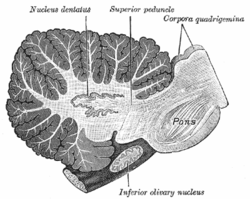Deep cerebellar nuclei
| Deep cerebellar nuclei | |
|---|---|

Sagittal section through right cerebellar hemisphere. The right olive has also been cut sagittally. (Nucleus dentatus labeled at center top.)
|
|

Microcircuitry of the cerebellum. Excitatory synapses are denoted by (+) and inhibitory synapses by (-).
MF: Mossy fiber. DCN: Deep cerebellar nuclei. IO: Inferior olive. CF: Climbing fiber. GC: Granule cell. PF: Parallel fiber. PC: Purkinje cell. GgC: Golgi cell. SC: Stellate cell. BC: Basket cell. |
|
| Details | |
| Part of | Cerebellum |
| Components | Dentate nucleus, Emboliform nucleus, Fastigial nucleus, Globose nucleus |
| Artery | Superior cerebellar |
| Identifiers | |
| Latin | nuclei cerebelli |
| NeuroNames | hier-679 |
| NeuroLex ID | Deep cerebellar nuclear complex |
|
Anatomical terms of neuroanatomy
[]
|
|
The cerebellum has four deep cerebellar nuclei embedded in the white matter in its center.
These nuclei receive inhibitory (GABAergic) inputs from Purkinje cells in the cerebellar cortex and excitatory (glutamatergic) inputs from mossy fiber and climbing fiber pathways. Most output fibers of the cerebellum originate from these nuclei. One exception is that fibers from the flocculonodular lobe synapse directly on vestibular nuclei without first passing through the deep cerebellar nuclei. The vestibular nuclei in the brainstem are analogous structures to the deep nuclei, since they receive both mossy fiber and Purkinje cell inputs.
From lateral to medial, the four deep cerebellar nuclei are the dentate, emboliform, globose, and fastigii. Some animals, including humans, do not have distinct emboliform and globose nuclei, instead having a single, fused interposed nucleus. In animals with distinct emboliform and globose nuclei, the term interposed nucleus is often used to refer collectively to these two nuclei.
In general, each pair of deep nuclei is associated with a corresponding region of cerebellar surface anatomy.
Cross-section of human cerebellum, showing the dentate nucleus, as well as fourth ventricle
Cross-section of human cerebellum, showing the dentate nucleus and cross-section of vermis
These structural relationships are generally maintained in the neuronal connections between the nuclei and associated cerebellar cortex,
...
Wikipedia
